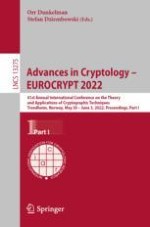Abstract
A common technique for enhancing the efficiency of
secure multiparty computation (MPC) with dishonest majority is via preprocessing: In an offline phase, parties engage in an input-independent protocol to securely generate correlated randomness. Once inputs are known, the correlated randomness is consumed by a “non-cryptographic” and highly efficient online protocol.
The correlated randomness in such protocols traditionally comes in two flavors: multiplication triples (Beaver, Crypto ’91), which suffice for security against semi-honest parties, and authenticated multiplication triples (Bendlin et al., Eurocrypt ’11, Damgård et al., Crypto ’12) that yield efficient protocols against malicious parties.
Recent constructions of pseudorandom correlation generators (Boyle et al., Crypto ’19, ’20) enable concretely efficient secure generation of multiplication triples with sublinear communication complexity. However, these techniques do not efficiently apply to authenticated triples, except in the case of secure two-party computation of arithmetic circuits over large fields.
In this work, we propose the first concretely efficient approach for (malicious) MPC with preprocessing in which the offline communication is sublinear in the circuit size. More specifically, the offline communication scales with the square root of the circuit size.
From a feasibility point of view, our protocols can make use of any secure protocol for generating (unauthenticated) multiplication triples together with any additive homomorphic encryption. We propose concretely efficient instantiations (based on strong but plausible “linear-only” assumptions) from existing homomorphic encryption schemes and pseudorandom correlation generators.
Our technique is based on a variant of a recent protocol of Boyle et al. (Crypto ’21) for MPC with preprocessing. As a result, our protocols inherit the succinct correlated randomness feature of the latter protocol.
